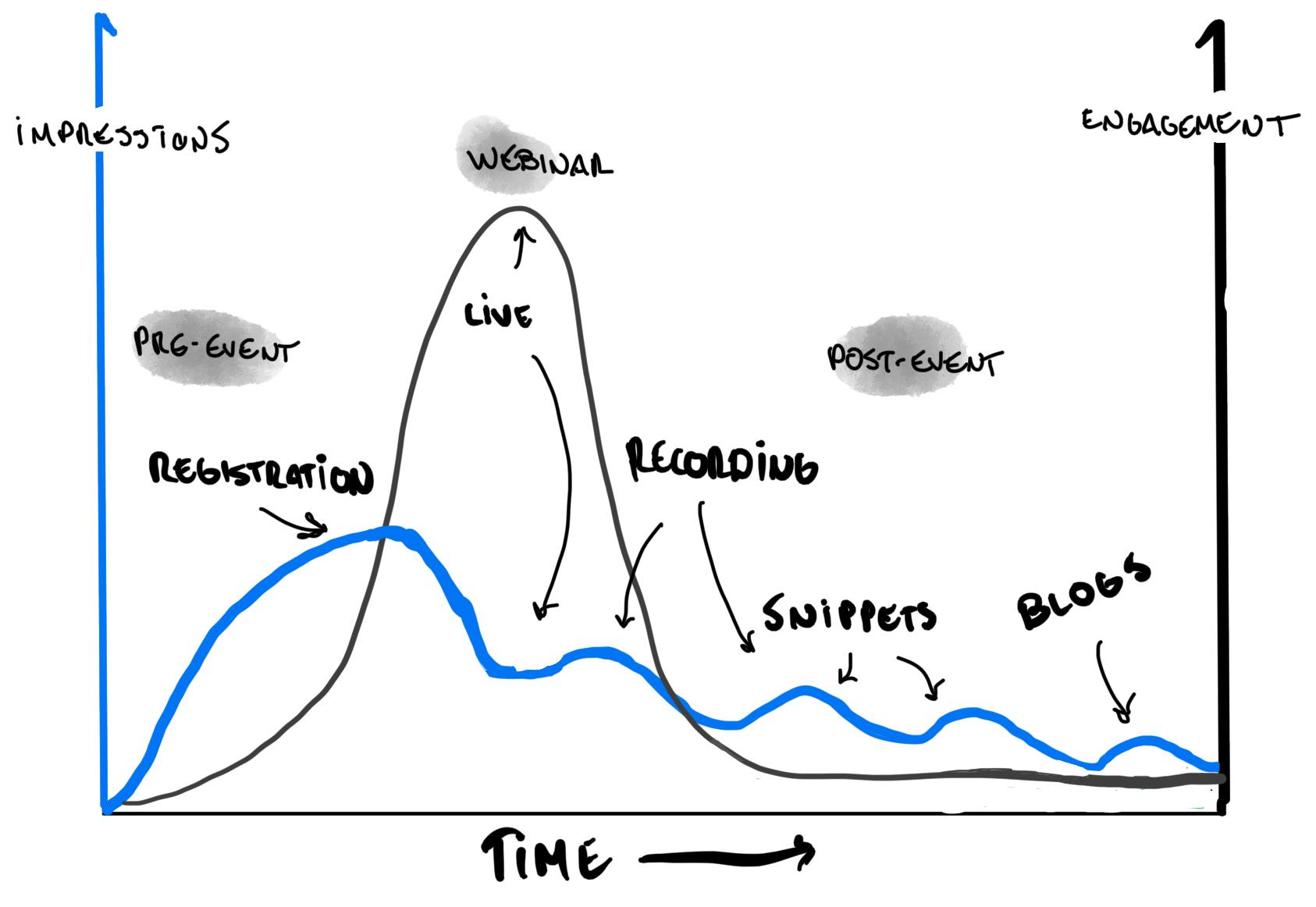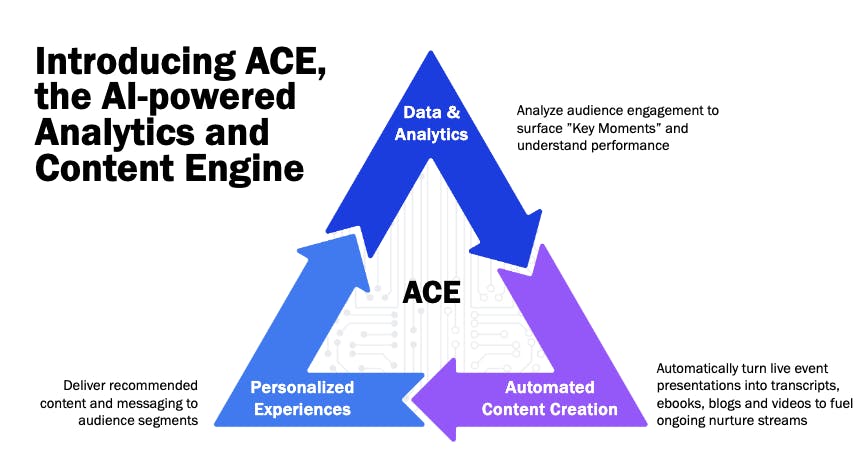- Marketers report that webinars generate higher-quality leads and more effectively move prospects through the marketing funnel compared to other tactics. Not to mention, registrants provide first-party data, including verified email addresses, populating or enriching CRM profiles. This is particularly valuable In a world where cookies are on their way out, click rates on ads and social media are vanishingly small, and email inboxes are crowded. In short, webinars offer a reliable route to high quality engagement with a brand’s audience. One interviewee used the phrases “unique opportunity to build trust,” and “nothing like it other than physical events to get people bought in.”
A webinar is characterized by a uniquely shaped engagement curve. This is dictated by the three distinct webinar phases:
- There’s the baseline set by registrations
- The intensely engaged but relatively small in-event audience
- Third, the post-event “dragon tail,” generated by recordings, snippets, and other content exhaust from the event. This tail tends to flatten over time but is long and has potentially high peaks.

Mastering the webinar lifecycle
To marketers and community managers, the webinar format’s attractiveness lies in the opportunity to “triple dip,” i.e. to spur audience engagement and gather data in pre-event, in-event, and post-event phases. This is unlike other content formats in which attention focuses on one or two touchpoints, e.g. a white-paper sign up and its delivery.
A significant portion of registrants sign up not to attend the live event, but to receive a recording afterward. Further impressions and views can come from downstream snippets, reports, and blog posts based on the in-event content. In-event data can be used to select snippets and content themes to optimize content creation. Overall, the long-tail audience and impressions are significantly larger than the registrant pool, not to mention the live audience.
The three webinar phases offer different opportunities for audience growth and engagement.
- Pre-event webinar promotion and registration creates a window for re-engagement and identification of existing audiences but also for top-of-funnel expansion through promotion on social, email, and other channels.
- In-event interactions and attention result in high quality engagement and depthful interactions, which are extremely valuable in generating signals and data that help marketers qualify leads and learn how to better move audiences closer to a desired action.
- In terms of reach and impressions, the post event phase is key, accounting for three to ten times the pre- and in-event audience and views. In this phase, webinar recordings and transcripts can be transformed into fresh content for an extended long-tail of engagement. By leveraging post-event content workflows — especially if aided with in-event engagement data — marketers are able to significantly boost the overall return on investment for each webinar event.
The most successful webinar strategies design these phases so that they form an integrated loop. Competitors are encouraging leveraging of data and gen AI for automated content flywheels hinging on post-event campaigns. These include ON24 with beta feature ACE (Analytics & Content Engine) and Goldcast with Content Lab.

Source: ON24, Q4’23 investor presentation
In this way, webinars lead to constellations of related content on key topics, which grow and deanonymize the brand’s audience, in turn leading better-attended webinars with more attuned attendees likelier to engage and participate, and so on.
Opportunities in the webinar lifecycle
Pre-event promotion processes are very similar to those involved in other types of campaigns, involving cross-channel promotion, landing pages, forms, email capture and drips. Marketing teams are comfortable managing these workflows. There are doubtless opportunities to make webinar registration experiences more dynamic and increase conversion rates. And there’s a need for lead-capture data to flow seamlessly into the following two phases.
From interviews and research, it’s clear that it is in the in-event and post-event phases where there is a more acute market need for novel solutions and approaches that can help tilt webinar ROI further into the black. So it’s really in the latter phases where webinars and live events depart from the routine marketing playbook.
- In-event, there is a market hunger for affordances and guidance that will help marketers stoke audience attention and engagement. Hosting a webinar is much more like holding an in-person event than it is like distributing a run-of-the-mill content-marketing asset like a blog post or report. The most successful webinars and webinar products will lean into the potential for in-event spontaneity, interactions, “stagecraft”, and multimedia.
- Post-event, marketers face a big opportunity but also a challenge. The webinar video recording, transcript, and any accompanying slides or other content are extremely valuable assets. They can be repurposed into a robust stream of repurposed content. But that also takes further time and attention, and ideally requires integrations with other parts of the marketing stack to be done easily.
Three key market interests emerged from our initia`l phases of research:
- Features to enable and encourage audience engagement, particularly in-event. Successful consumer products like Twitch, YouTube Live, Clubhouse and Twitter Spaces have redrawn audience preferences. There is a growing expectation for multimedia, engaging real-time mechanics, as well as a revaluing of spontaneity and authenticity in approaches.
- Features to optimize the creation and distribution of post-event content, as marketers can see 10x the audience reach and impressions they see in the course of the live event.
- Access to granular audience identity and engagement data over the course of the event lifecycle, particularly for in-event analytics since that is when engagement is most intense. This need encompasses audience analytics and lead-gen data points, and the passing of this data via deep MAP and CRM integrations and/or APIs.
Most businesses use two or more tools to manage workflows across the different phases of the webinar lifecycle.
One interviewee used at least four separate tools:
- Different landing page tools for registration pages
- Livestream tool for holding the webinar (Restream)
- Video-recording and snippet editing in Descript
- YouTube for video hosting
- Typefully for pushing snippets and recordings to social
Another used Vimeo for hosting in concert with Zoom for webinars, Storyblok for landing pages, with a Blueconic CDP working in concert with other automations and triggers to distribute pre-and post-event emails and triggers.
In fact in all cases, a MAP of some sort was used and doubled as a “system of record,” for tracking and managing marketing campaigns. While interviewees were receptive to the idea of consolidating their webinar stack onto a video-hosting provider, the only concern was ensuring that they wouldn’t lose visibility in their MAP into how webinars fit into their overall marketing campaigns and workflows.
Other Key Findings
- Market edges: Customers do not distinctly separate webinar products from videoconferencing, marketing suites, livestream tools, or virtual-events software. As such, the purchase decision for webinar software most commonly starts with a canvassing of current vendors’ capabilities in this area.
- Consolidation: Often, the purchase decision is influenced by a cost-driven desire to consolidate — or at least not add — vendors.
- Visual quality: While visual quality is expected and there is a “hurdle” here to surpass, it's not the primary criterion for webinar software.
- Integrations: Software integrations, including with MAPs, CMSs, and CRMs, are highly valued, but their mere availability is “table stakes” and customers rate integrations based on the depth of data and access they offer.
- In-event engagement: In-event engagement tools are important for experience quality and maintaining attention, but crucial for in-event data generation.
- Branding: Branding is important. Webinar users definitely want as much control as possible over the branding of their registration pages, videos, and post-event assets. Because webinars have such immediacy as synchronous, first-degree contact with a brand’s audience, there is a perception that control over branding is a “must have.”
- Ease-of-use vs. configurability: This is a wash, as prospects seem to signal a middle ground is acceptable, and are willing to take on a modest learning curve for superior control and results. Webinar solutions rated relatively more difficult to use do not necessarily suffer in overall customer adoption or reviews.
- APIs: Webinar point solutions including Livestorm and Airmeet boast APIs that allow for webinar automation and programmatic access to webinar-related data. For example, you can fetch all the questions asked in a webinar, generate custom reports, and see participants, sessions, attendance, etc.
- Simulive: In terms of the reasons behind simulive webinars, interviewees will mention the desire to “avoid mistakes or video glitches.” But with further discussion it’s clear simulive is driven by the already-mentioned resource issue. Live broadcasts have overhead. There’s the careful preparation along with the real-time staffing required in live video. With simulive, pressure is relieved. Planning, prep, and production can be spread out and become more manageable. That said, simulive is somewhat divisive, and not just because of a reluctance to “fake” live video. There is a perceived trade-off in terms of engagement. Marketers note that true live experiences uniquely allow for on-camera reactions to audience input, and that authenticity leads to more, and higher-quality, engagement. This may be the case whether or not audiences know the video is simulive.
Adoption and decision paths
- Go-to-Market Strategy: Webinar software adoption tends to follow a bottom-up approach, initiated by junior marketing members and/or middle managers. This suggests the need for easy self-service experiences with accessible sales support for more detailed inquiries.
- Traffic: For a competitive cohort of webinar point solutions, LinkedIn was a significant source of traffic for marketing pages: 1 out of 25 visits for Livestorm.


